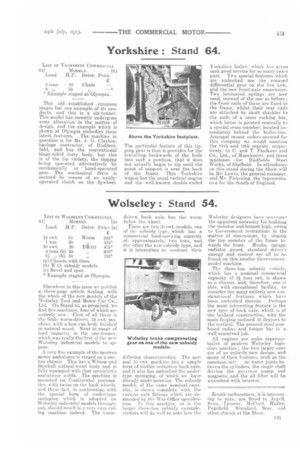Wolseley : Stand 54.
Page 39

If you've noticed an error in this article please click here to report it so we can fix it.
Elsewhere in this issue we publish a three-page article dealing with the whole of the new models of the Wolseley Tool and Motor Car Co., Ltd. On Stand 54, as promised, we find five machines, four of which are entirely new. First of all there is the little worm-driven, 12 cwt. machine. with a box-van body finished in natural wood. Next in range of load capacity is the one-tonner, which was really the first of tile new Wolseley industrial models to appear.
A very fine example of the modern motor ambulance is staged on a oneton chassis. This has a Wilson and Stockall natural-wood body and is fully equipped with that specialist's ambulaace outfit. The machine is mounted on Continental pneumatics, with twins on the back wheels, and these last, in conjunetion with the special form of under-type springing which is adopted on Wolseley industrial models throughout, should result in a very easy-riding machine indeed. The worm
driN en hack axle has the worm belom the wheel.
There are two 30 cwt. models, one of the subsidy type, which has a commercial load-carrying capacity of. approximately., two tons, and the other the non-subsidy type, and it is interesting to contrast their differing characteristics. The normal 30 cwt. machine has a simple form of double-reduction back axle, and it also has embodied the undertype springing, of which we have already made mention. The subsidy model, of the same nominal capacity, is shown complete with the various axle fittings which are demanded by the War Office specification. To this machine, as in the larger three-ton subsidy example, visitors will do well to note how the Wolseley designers have overcome the apparent necessity for building the radiator and bonnet high, owing to Government restrictions in the matter of dimensions, by sloping the top member of the frame towards the front. Hooks, sprags, radiator guard, standard driver's canopy and control are all to be found on this smaller Governmentmodel machine.
The three-ton subsidy vehicle, which has a nominal commercial capacity of ai tons net, is shown as a chassis, and, therefore, one is able, with exceptional facility, to consider the many entirely new constructional features which have been embodied therein. Perhaps the most interesting feature is the new type of back axle, which is of the bridged construction, with the main forging inclined 45 degrees to the vertical. The pressed-steel combined radius and torque bar is a well-conceived job.
All engines are (mite representative of modern Wolseley highclass practice ; the two larger ones are of an entirely new design; and many of their features, such as the camsnart 'ne water joints between the cylinders, the single shaft driving the governor pump and magneto, and the oil filter will be examined with interest.
Zenith carburetters, it is interesting to note, are fitted to Argyll, Benz. Licorne, McCurd, Pagefield, Standard, Star, and other chassis at the Show.








































































